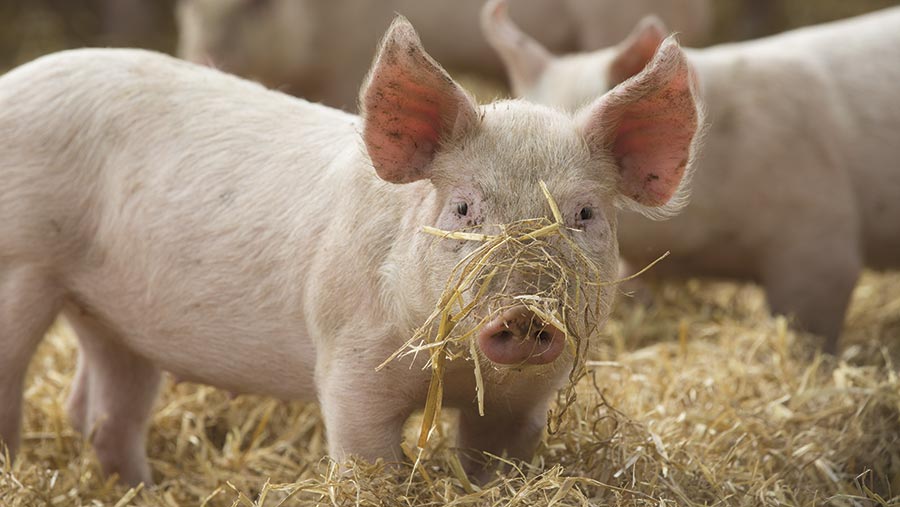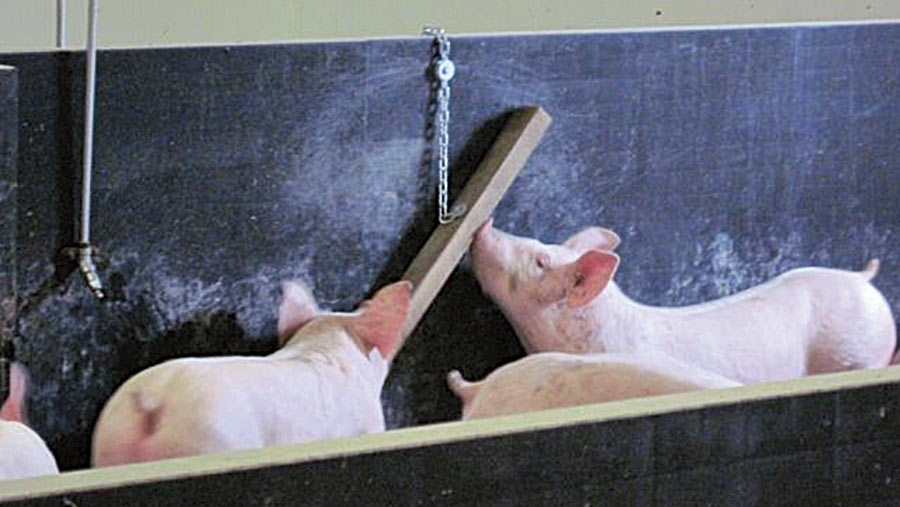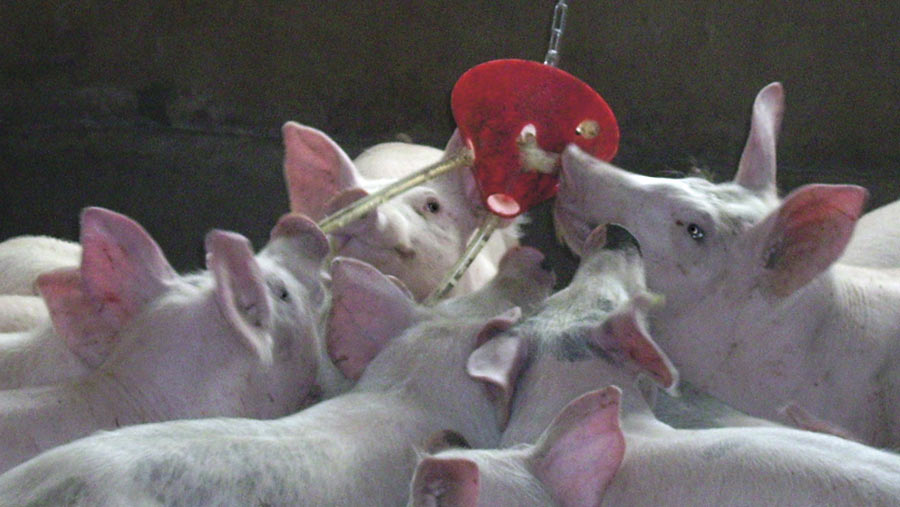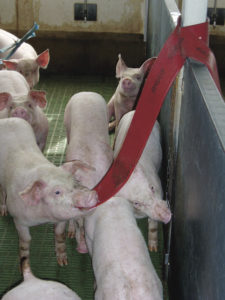Farmer’s guide to different enrichment types for pigs
It is a legal requirement that all pigs in the UK are provided with some form of environmental enrichment.
Research has found when pigs are happy and less frustrated they are less likely to carry out undesirable behaviours, such as tail biting.
See also: Red Tractor enrichment standards
Every year £3.5m is lost in the UK pig industry through tail biting. And to try and prevent this it’s important to prevent pigs being bored.
See the top tips on selecting the right enrichment tool, the comparison of enrichment types and enrichment advice below. Information provided by AHDB Pork.
Top tips on selecting the right tool
1. Novelty
It’s the novelty factor that really engages pigs. If you supply enrichment in the form of objects then you may need to use more than one type and change it regularly, or present it in a different way.
2. Level of engagement
If less than 50% of pigs are engaging with the object or substrate then it needs changing.
3. Keep it simple
Simple objects can often work well.
4. Keep it clean
Objects that gets soiled or dirty will be less interesting to pigs. It’s important to observe what the engagement is with the enrichment.
5. Easy upkeep
Make sure that they can be easily cleaned and also easily changed.
6. Take care
Caution should be taken when using various forms of enrichment. For example, beware when using mushroom compost as that can carry bacteria and other micro-organisms.
Railway sleepers may also carry some toxins, as can recycled shredded paper as it can carry print toxins.
Root vegetables are a good source of enrichment, but remember parsnips can be toxic to pigs. A
nd when using wood, it shouldn’t be treated and should be size appropriate for the pig and not be able to fit through slats otherwise it will block up the system.
7. Bedding
In housing, where bedding materials cannot be provided as a source of enrichment, then other enrichment materials and objects should be provided.
8. Slatted floors
AHDB Pork suggests object-based enrichments are best suited for pigs in systems on slatted floors.
9. Variety
Use two or more enrichments at any one time.
Type of enrichments
The AHDB Pork Real Welfare scheme assessed 5,463,348 pigs between 2013 and 2016 and noted the following enrichments:
- 60.8% had access to straw
- 2.5% other substrate
- 16.4 chain without attached object
- 21.4% plastic object
- 7.1% other object
- 1.7% no enrichment seen
Enrichment types compared
Definition of ratings
- Optimal will provide all the enrichment requirements of a pig – it is manipulable, edible, investigable and chewable. No additional enrichment is required.
- Suboptimal meets almost all of the above, but not quite
- Marginal meets on or two criteria, such as manipulable or chewable, but will need supplementing with an optimal or suboptimal enrichment type.

© Tim Scrivener
Straw
Rating Optimal (when used as bedding)
Pros
- When provided in racks it is easy to access and can easily be refilled by staff
- It is edible, chewable and manipulable
Cons
- In high temperatures, lots of straw could increase the risk of heat stress so areas of no straw may need to be provided
- It is costly
- A tray may need to be placed under the rack to prevent straw affecting the slurry system
- Can be time-consuming to replenish
- When provided in racks it becomes difficult to investigate
Advice
- Refill regularly
- Keep clean and dry
Cost
- High
- £60/t
Vegetation
Rating Optimal
Pros
- Edible, investigable and manipulable
- Can be provided on its own
- Plays a role in physical comfort and thermal regulation
Cons
- May require replenishing twice daily
- Significant time and cost associated with use
- Can only be used in outdoor systems or indoor if pigs are housed on straw
Advice
- Provide enough to avoid competition
- In high temperatures, it can increase the risk of heat stress so areas of no substrate may need to be provided
Cost
- Medium-high

© AHDB
Fresh wood
Rating Sub-optimal
Pros
- This can be added in the pen in various ways – either suspended by a chain or left on the floor
- Chewable and manipulable
- It can also be put into a holding tube with commercial products available
Cons
- Not always edible and investigable
- Some wood may cause damage to pigs
Advice
- The size of wood blocks should be proportional to the size of pigs
- Enough pieces should be provided to avoid competition between pigs
- It is important to ensure wood is not dried or splintered
- Wood pieces should be large enough so they don’t fall down slats and damage slurry equipment
- Yew is poisonous to pigs so this should be avoided.
Cost
- Low
Paper or cardboard
Rating Suboptimal
Pros
- Chewable, manipulable and may be edible
- Cardboard can be used as sheets or a box can be provided on the floor
- Paper can be provided in shredded format or as sheets
Cons
- May not be suitable for slats as they could clog up slurry systems
- Needs to be complemented with edible and investigable material as it is not investigable
Advice
- Enough must be provided to avoid competition
- Make sure there are no print toxins on paper especially when using recycled material
Cost
- Low-medium
Root vegetables
Rating Suboptimal
Pros
- Edible, chewable, investigable and manipulable
- Can be provided lose or in a rack
Cons
- May require a lot depending on numbers
- Can affect rationing
- Needs replacing regularly
- Don’t use parsnips as they are poisonous to pigs
Cost
- Variable depending on the season but can be quite expensive

© AHDB
Footballs, wellies and plastic toys
Rating Suboptimal
Pros
- Minimal installation in terms of time and cost
- Chewable and manipulable
Cons
- Not edible or investigable
- If presented loosely in a pen toys can become soiled quickly and reduce interest
Advice
- Never introduce dirty wellies as this can transmit disease and be a health risk to pigs
- Presenting objects in different ways can extend the novelty of it
- Provide enough to prevent competition
- Should be complemented by optimal or another sub-optimal enrichment
Cost
- Low-medium
- Commercial toys range from pennies to £25
Rope (sisal or hemp)
Rating Suboptimal
Pros
- Easy to install and can be suspended or wrapped around pen fittings
- Knots can be added to increase complexity and make it more difficult for pigs to break bits off
Cons
- Ropes that break off can pass through slats and intervene with slurry systems
- Edible and of limited investigable quality
Advice
- Provide enough to prevent competition
- Should be complemented by edible and investigable material
Cost
- Low cost
Strong hosepipe

© AHDB
Rating Marginal
Pros
- Easy to attach as can be wound around the bars of gates and suspended or fixed to pen walls
- Chewable and manipulable
Cons
- Must be changed regularly to try and maintain pigs’ interest
- Not easily investigable
Advice
- Enough hosepipe should be provided to prevent competition
- Should be thick enough so it cannot pass through slats
- Should be complemented by optimal or suboptimal enrichment
Cost
- Low
Enrichment checks
When choosing enrichment make sure it is:
- Safe
- Sanitary
- Suspended
- Soft
- Simple
How to recognise insufficient enrichment
Signs of insufficient enrichment could include:
- More aggressive behaviour directed at pen-mates. This can include fighting or chewing and ear, flank or vulva biting
- Excessive drinking or chewing on nipple drinkersBiting or chewing at pen fittings
- Biting or chewing at pen fittings
- Unsettled pigs
- Increased noise
Enrichment needs
Pig enrichment should fulfil the following:
- Edible or feed-like so pigs can eat or smell them, preferably with some nutritional benefit
- Chewable so pigs can bite them and also provides information on taste/odour
- Investigable so pigs can investigate them, allowing pigs to root with their snout
- Manipulable or deformable so that pigs can change their location, appearance or structure
Source AHDB Pork and tips from Claire Barber, welfare officer at AHDB Pork
More information can be found in the AHDB Pork’s new enrichment guide [PDF]
